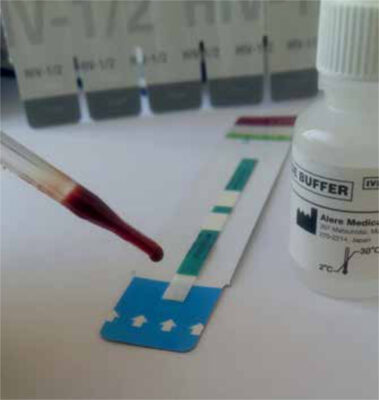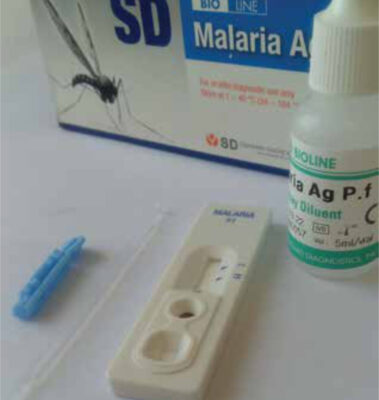Main content
Rapid diagnostic tests (RDTs), which were initially developed for rapid field testing, were quickly incorporated in routine laboratory testing and have now become commonplace in the health delivery system.[1] In resource constrained settings, a number of donor funded programs have pushed for their use in non-laboratory settings such as health clinics. This expansion raises the question of what this means for laboratories.
Laboratories in resource constrained countries
Laboratories in resource constrained countries are typically organised into a four-tier system consisting of peripheral, district, provincial and central laboratories. The breadth and complexity of tests within this network increases from the peripheral laboratory, where basic tests are performed, through to the central laboratory, where highly complex tests are conducted.[2] The parcelling out of test menus and upward referral of complex tests through the tier seeks to take advantage of the different resource capacities (infrastructure, equipment, staff etc.) at each level.
The major push for improvements in laboratories in resource-constrained settings has been the need to improve quality and increase access to testing. Although significant efforts have been made to strengthen laboratories over the past few years, challenges still exist. These include limited infrastructure and personnel, unavailability of functional equipment, lack of equipment maintenance contracts, and intermittent power supply. In addition, specimen referral systems may not always operate as efficiently as intended and reagent stock-outs that are attributed to funding gaps and/or shipping delays occur frequently, resulting in repeated work interruptions.[3,4]
Rapid diagnostic tests
RDTs are basically non-automated testing devices that can be used individually or in sequence with other devices to provide, in a relatively short time frame, a qualitative or semi quantitative result from patient samples.[5] The tests detect markers such as bacterial, viral or parasite antigen or antibody in body fluids and can employ any of three techniques: direct agglutination, latex agglutination and lateral flow strips. Tests that employ the first two techniques often require refrigeration and are performed within a traditional laboratory setup. Examples include tests for febrile antigens (Widal and Weil Felix), rheumatoid factor, C-reactive protein, and rapid plasma reagin (RPR) for syphilis. Lateral flow based tests such as those for pregnancy, HIV, malaria, and syphilis generally do not require refrigeration. These tests have a long shelf life of up to 2 years and can be performed outside the traditional setting with minimal training required. They also require very small sample volumes, and results are usually available within 15 minutes. Most RDTs are comparable in performance to established methods.[6]

RDTs: benefits and challenges
RDTs have many benefits such as low cost, close to patient, and same day testing options that allow for more prompt patient management decisions within a single visit to the health facility, thereby reducing follow-up loss. In areas with limited infrastructure or personnel, non-laboratory cadres such as community health workers (CHWs) can be trained rather quickly and inexpensively to perform RDT outside the traditional laboratory environment, thereby improving access to testing.[7] RDTs also present a viable option as they utilise small sample volumes where testing is conducted immediately after sample collection. This in turn eliminates steps that are usually taken when samples are referred to the main laboratory. The small size and portability of the RDT also make them more suitable to a variety of testing environments.[8]
The use of RDTs offers a simple solution to address access to testing. However, various challenges need to be addressed and taken into consideration when implementing RDTs. First, some tests have several alternatives, which may vary in performance or not even be WHO prequalified. In order to ensure reliable results, minimum test performance standards must be established. Second, although RDTs are relatively easy to perform, errors can still occur, especially when testing is conducted by lay people who lack understanding or training in the use of RDTs and interpretation of the results (e.g. a positive syphilis antibody RDT result does not distinguish between an active and a previously treated infection) as well as QA/QC related issues.[8] Also, post market surveillance may not be diligently conducted. Finally, it is important to note that understaffing is common in resource constrained countries, and at times the introduction of new RDTs in non-laboratory settings such as clinics may still increase workload pressures on existing staff, thus impacting on workflow and patient waiting times.[9]
RDTs in routine laboratory testing
The many attributes of RDTs present an opportunity for incorporation into routine testing within the core laboratory. For instance, RDTs are being used as alternative or supplemental tests for the screening and diagnosis of infectious diseases.[1] Typical examples include RDTs for HIV, malaria, syphilis, TB and cryptococcal meningitis. Additionally, the organisation of national laboratory networks into a tiered system in which RDTs are conducted at peripheral level demonstrates the value and contribution of RDTs to not only increasing access but affording an opportunity for timely patient management decision making.[2]

Quality RDT results: laboratory role
The implementation of RDTs and especially their deployment in non-laboratory settings does not diminish the importance of the laboratory. In fact, the laboratory is expected to play an even bigger role. The laboratory’s responsibility in providing quality RDT results lies in ensuring that standardised quality diagnostics are available. One of the key attributes of RDTs is that results should be comparable to an established laboratory method.[10] By inference, the laboratory’s role is to identify the established method and set minimum test performance criteria for the RDTs to be evaluated. The performance criteria are then used as the basis for the selection and evaluation of RDT technologies. The laboratory should also ensure that the evaluation process extends beyond the laboratory setting, so that RDT performance results accurately reflect the clinical setting testing in which the test will eventually be conducted.[11,12]
By working closely with the Ministry of Health and other partners, laboratories should also take the lead in the development and implementation of guidelines, testing algorithms, standard operating procedures, end user training, and providing QA/QC support to testing sites through preparation and distribution of proficiency testing (PT) and QC material.[13] Laboratories in turn need to implement quality management systems (QMS) and participate in external quality assurance (EQA) schemes to ensure that they in turn are able to provide quality testing within their network.[9]
Conclusion
RDTs have been shown to complement and support routine laboratory testing in resource-constrained settings. A number of quality issues arise with testing being done in non-laboratory settings. The laboratory should anticipate and address these issues so that diagnostic quality is not compromised. This will ensure that RDTs are powerful resources to increase access at points of care and reduce loss to follow-up.
References
- El-Moamly AA. Immunochromatographic Techniques: Benefits for the Diagnosis of Parasitic Infections. Austin Chromatogr. 2014;1(4): 8.
- Best M, Sakande J. Practical recommendations for strengthening national and regional laboratory networks in Africa in the Global health era. Afr J Lab Med. 2016; 5(3), a471.
- Olmsted SS, Moore M, Meili RC, et al. Strengthening Laboratory Systems in Resource-Limited Settings. American Journal of Clinical Pathology 2010; 134(3): 374-80.
- Fitzgibbon JE, Wallis CL. Laboratory Challenges Conducting International Clinical Research in Resource-Limited Settings. J Acquir Immune Defic Syndr. 2014; 65(01): S36-S39.
- WHO. Global Malaria Programme. Good practices for selecting and procuring rapid diagnostic tests for malaria. World Health Organisation. 2012.
- Drancourt M, Michel-Lepage A, Boyer S, Raoult D. The point-of-care laboratory in clinical microbiology. Clin Microbiol. 2016;29:429-447.
- Laktabai J, Platt A, Menya D, et al. A mobile health technology platform for quality assurance and quality improvement of malaria diagnosis by community health workers. PLoS ONE 2018; 13(2).
- Futrell K. Laboratory Point-of-Care Testing: A Future Outlook. 2015.
- Kyabayinze Dj, Achan J, Nakanjako D, et al. Parasite based malaria diagnosis: Are Health Systems in Uganda equipped enough to implement the policy? BMC Public Health 2012; 12: 695.
- Gami U. Emerging Technologies for Point-of-Care (POCT) Testing: A future outlook for Scientists and Engineers. Researchgate. 2018.
- Pereira P. Evaluation of Rapid Diagnostic Test Performance. In: Saxena SK (ed). Proof and Concepts in Rapid Diagnostic Tests and Technologies, 1st Edition: InTech; 2016. P.139-161.
- Drain PK, Hyle EP, Noubary F, et al. Evaluating Diagnostic Point-of-Care Tests in Resource-Limited Settings. Lancet Infect Dis. 2014; 14(3): 239-249.
- Carter JY. External quality assessment in resource limited countries. Biochemica Medica 2017; 27(1): 97-109.



















































